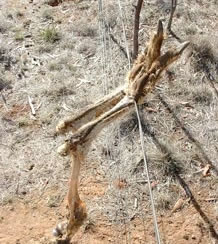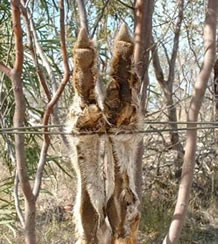Wildlife friendly fencing
For most of us, what landholders use for their fencing is rarely given thought or, even rarer, a second thought.
However it is something that we all need to give thought to. Each year thousands of injuries are sustained by wildlife from the use of fencing that has had no consideration of what affects it may have on wildlife. These injuries range from the minor to horrific deaths.
More than 75 wildlife species have been identified in Australia as occasional or regular victims of barbed wire fences, especially nocturnal animals such as bats, gliders and owls. This problem is not unique to Australia and its occurrence in other countries is well documented.
Just take a moment to imagine what it would be like to be trapped, to die from exposure, thirst, fright or worse – to be eaten alive!
One example – Kangaroo ‘fencehanging’, occurs when a kangaroo attempts to jump a fence but misses the top. Instead its leg or legs pass between the top wire and the next one down. The body then flies forward over the top and as it falls towards the ground pulls the second wire over the top wire and trapping the leg(s) tight and acting like a tourniquet.


Photos: Rob Schmidt
As illustrated in the above photos it is not just barbed wire that causes havoc, however it is a major factor in injury and deaths. In many cases barbed wire does not perform an essential function in its inclusion in fencing solutions and where it is essential relatively simple measures could be utilised to reduce its impact. However because there is so much barbed wire in the Australian landscape, in both rural and urban environments, combined with little awareness of the issues it is a daunting task for those wishing to educate its users.
![]()
There are two main factors in Wildlife Un-Friendly Fencing: Design and Positioning. To aid in the education and use of Wildlife Friendly Fencing there are resources available for those willing to take an interest in providing the best possible solution for land management and wildlife. The main resource in Australia for this service is the Wildlife Friendly Fencing project.

The Wildlife Friendly Fencing website is at www.wildlifefriendlyfencing.com.
Wildlife Friendly Fencing is fencing that is safe and effective for wildlife, people and livestock. It:
- does not entangle or harm wildlife.
- allows the appropriate free movement of wildlife across rural and urban landscapes.
- may mean no fence at all.
What you can do:
- Make your fences wildlife friendly.
- Monitor barbed wire fences in your area and encourage landholders to go wildlife friendly.
- Encourage the promotion of wildlife friendly fencing by natural resource management groups, Councils, fencing contractors and suppliers.
- Help distribute the WFF brochure.
- Visit www.wildlifefriendlyfencing.com for advice and information.
Report entangled animals to your local wildlife rescue organisation. You can find them at www.fauna.org.au Rescue is best left to experienced carers with the skills to minimise further harm, and who can take the animal into care for assessment and rehabilitation.
Please do not attempt to handle flying foxes or bats by yourself.
There is no funding to run or coordinate the project. Tolga Bat Hospital was awarded a grant from the World Wide Fund for Nature (WWF) in 2006 to begin the project and continues to coordinate the project on a voluntary basis. They welcome donations to continue this work and all donations are tax deductible.
Jennefer Maclean of Tolga Bat Rescue and Research Inc (Tolga Bat Hospital) in Atherton Australia is the coordinator of the Wildlife Friendly Fencing project. “We are currently producing a new wildlife friendly fencing brochure to be accompanied by a matching wildlife friendly fruit tree netting brochure. Three videos will be put on the website on how to net your fruit trees without endangering wildlife.”
The information used to write this blog is freely available. The direct quotes and images from the website www.wildlifefriendlyfencing.com has been used with permission.